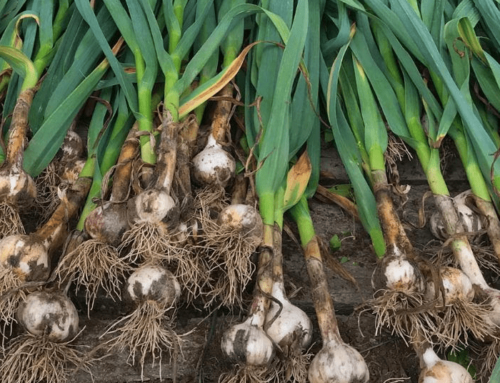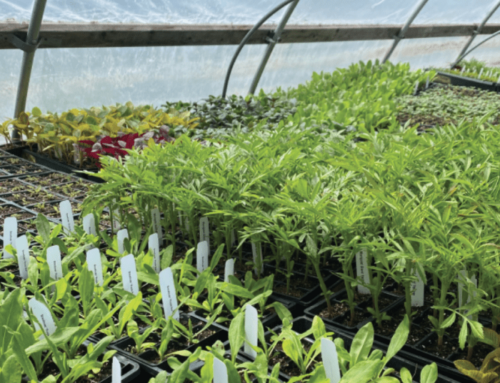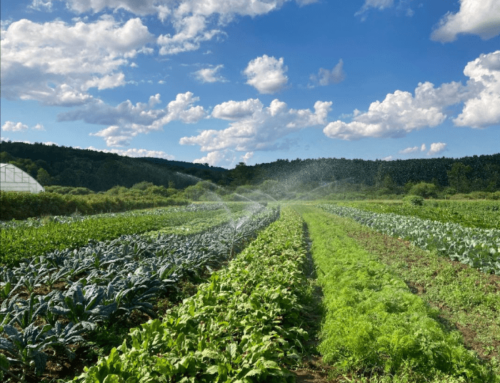By Ophelia Jackson, NOFA/Mass Intern

Ingredients, left to right: ginger/kombucha puree, raspberry hibiscus preserves, spicy honey, Tazo lemon strawberry tea, Celestial Peppermint and Raspberry Zinger teas. Photo credit: Ophelia Jackson
At once teeming and leisurely, summer is a sprawling season—a time for both quiescence and wandering, retreat and expansion. Feet are loosed from shoes, vines overreach their trellises, days are freed from the regimens of the classroom; in childhood, it is the part of the year in which it seems anything might happen, and even as adults, summer often retains some of this abundance of possibility. If the ample sunlight and rambling twilights call many to travel, they can also invite us to venture out in other ways as well, shifting our routines or exploring new practices. Because warmer temperatures also hasten the fermentation process—and sweeten the savor of a cool libation—there is no better time of year to begin brewing kombucha. As the season comes to a close, moreover, this series will discuss the final stage of preparation, the second fermentation.
Many brewers sample, enjoy, or even serve “the raw,” or unflavored brew, and kombucha can develop a satisfying flavor and subtle effervescence after the first fermentation alone. The second fermentation, or bottle-aging stage, is the most creative stage of the process, however, offering the opportunity to create individual flavors, and see the brew’s characteristic carbonation fully develop.
What You Need
1. 1 gallon mature kombucha
Kombucha is ready to bottle age when it develops a vinegary aroma, when bubbles appear after pouring, when the color of the brew shifts from dark to light gold and, most importantly, when the flavor has reached the desired balance between sour and sweet. Thus, “maturity” is less an objective state than a subjective, personal judgment. Likewise, bottle aging is a fairly flexible and forgiving process, allowing brewers to accommodate both slightly over-sour and not-quite-ready brews.
2. Air tight, sealing bottles
The second fermentation can only take place in an anaerobic environment, and therefore requires bottles with an airtight seal; recycled, store-bought kombucha bottles with the lids screwed back on won’t suffice. I recommend swing-top lids and have used a set purchased at https://fermentaholics.com/product/kombucha-bottling-kit/ for several years now.
3. Secondary sweetener
Like the first fermentation, the second fermentation also requires a sweetener to catalyze the process and produce carbonation. There are a variety of options, including: sugar, honey, syrups, dried fruit, fruit juice, jams, and jellies. The maturity and flavor of the raw kombucha in the vessel determines the appropriate amount of sweetener to add to each bottle. If you would like to bottle age fairly early in the first fermentation while the brew is still sweet, it may not be necessary to add much additional sweetener. Conversely, if the kombucha has already turned quite sour, it’s possible to rebalance the flavor by sweetening the bottles more liberally.
As a general rule of thumb for 16 oz bottles of kombucha, try adding:
- 2 tsp sugar
- 2 tsp-1 ½ tbsp honey, syrup, jam, or jelly
- 2 Tbs dried fruit, minced or blended
- 3 Tbs-¼ cup fruit juice
- ¼ cup+ fresh fruit, chopped or blended
Note: I haven’t had much success with fresh fruit as a sweetener, since it often imparts a weak flavor, fails to catalyze the carbonation process, and fills up a lot of space in the bottle. (Pineapple is one exception to this, producing a pleasant tangy flavor and fizzy brew.) If you do use either fresh or dried fruit, I recommend finely chopping, or ideally blending, them to increase the surface area and therefore the flavor imparted.
4. Additional flavoring agents
To bottle age, it is sufficient to simply combine a secondary sweetener with the mature kombucha in a bottle and allow time for the second fermentation to occur. Adding additional flavoring agents can increase carbonation, as well as create unique, more complex flavors. These agents include teas, ginger, herbs, spices, and citrus juice or zest. Unlike in the first fermentation, it is fine to use herbal teas, since they will be in the bottle, rather than directly in contact with the SCOBY. (See the Recipes section below for inspiration.)
To a 16 oz bottle, add:
- 1 tea bag, torn open and emptied
- 2-3 Tbs lemon, lime, or grapefruit juice
- 1-2 tsp citrus zest
- Small pinch cayenne or cinnamon
- 2 tsps-2 Tbs ginger, grated or blended
Note: If using tea bags, I tear them open and empty the leaves directly into the bottles. Ginger is also an excellent additional flavoring agent, but grating a large amount can become a bit laborious. To prepare enough for multiple bottles, I blend it in a single-serving smoothie maker with a little raw kombucha. Any surplus puree can be kept in the refrigerator for future bottlings. Both ginger and mint tea increase carbonation levels in bottles.
5. Funnel
A funnel is very helpful for transferring flavoring agents and sweeteners into bottles. Ideally, its neck should be slightly smaller than the neck of the bottles so that it can be easily inserted.
6. Fine mesh sieve or strainer (for serving)
To remove the dregs of flavoring agents from kombucha when serving, pour it from the bottle into a glass through a sieve.
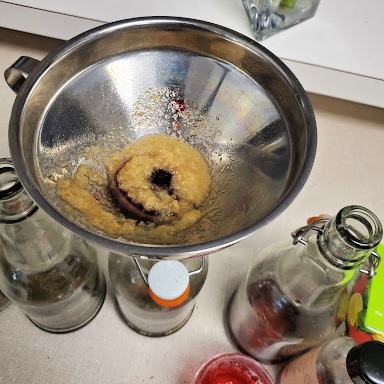
Adding flavoring agents and bottling for aging. Photo credit: Ophelia Jackson
Bottle Aging Steps
- Measure and place the ingredients, including the secondary sweetener and any additional flavoring agents, if desired, into the funnel, then rinse them thoroughly down into the bottles with a little mature kombucha.
- With a long-handled spoon, stir the kombucha in the main vessel to agitate any yeast that has settled at the bottom. After the first few brewing cycles, there may be only a small amount, but it will continue to accumulate as the SCOBY matures. Capturing yeast from the vessel in the bottles helps increase carbonation levels during the second fermentation.
- With kombucha from the vessel, fill all bottles completely to just below the lid, directly from the vessel if it has a spout. If not, remove kombucha with a siphon or cup.
- Bottle aging time can range from a few days to several months, and depends on many factors. Like with the first fermentation, maturity occurs more quickly in warmer temperatures. (During the summer, I keep my bottles in the garage while they are aging for this reason.) The more mature the kombucha was before the first fermentation—and the less secondary sweetener you add—the less time the second fermentation will require. I find that very long second fermentations often produce the most intense carbonation and complex flavors; as an eager new brewer, however, waiting months to taste your final product can be quite a tall order! Generally, a second fermentation of four days to two weeks is sufficient. When kombucha bottles are ready to open, bubbles may appear, rising from the bottom. During the second fermentation, store bottles in a warm, dark place.
- Allowing bottles to chill in a refrigerator for 45 minutes to an hour before opening reduces the risk of champagne-like explosions. Even so, it is often best to open them over the sink with some kind of catchment system at the ready; there is nothing worse than losing your long-awaited brew to spills. I prefer to transfer kombucha into glasses to serve, pouring it through a fine, hand-held mesh strainer to remove the dregs of flavoring agents.
Combining favorite ingredients and designing your own flavors is one of the most enjoyable parts of the kombucha brewing process. Experiment and get creative! Below are a few of my favorite recipes for inspiration.
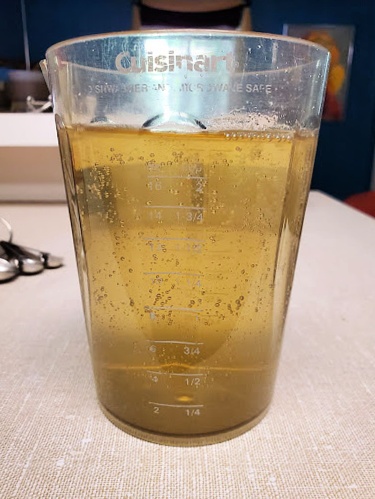
Finished flavored kombucha. Photo credit: Ophelia Jackson
Recipes
Berry the Hatchet (blueberry mint)
- 1 Tbs + 1 tsp to 2tbsps blueberry preserves
- 1 bag blueberry tea
- 1 bag mint tea
Raspy-Voiced Ginger (raspberry ginger)
- 1 Tbs + 1 tsp to 2 Tbs raspberry preserves
- 1 bag raspberry tea
- 2 tsp-2 Tbs ginger, grated or pureed
Pineapple Ginger
- ¼ cup pineapple, pureed or finely chopped
- 2 tsps-2 Tbs ginger, grated or pureed
- 2 tsps-2 Tbs lime juice
- 2 tsp lime zest
- small pinch cayenne
Read part 1 of this series here
Read part 2 of this series here


